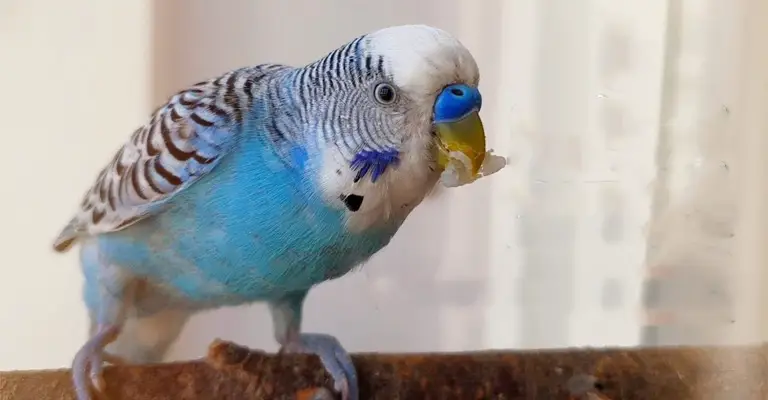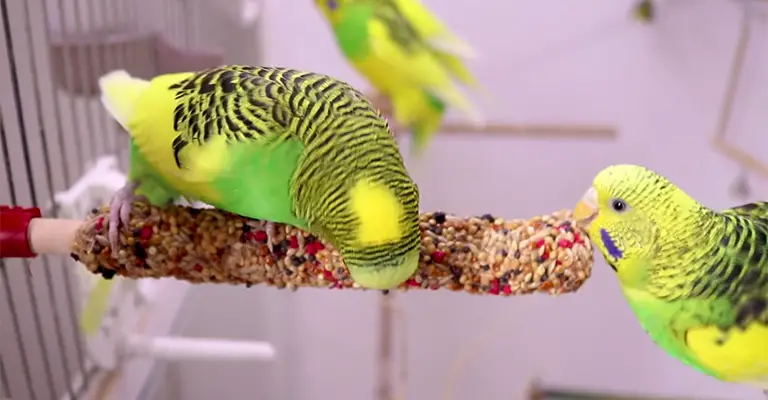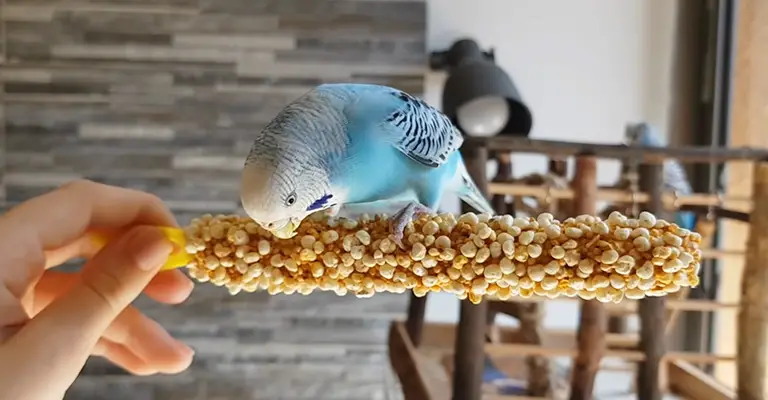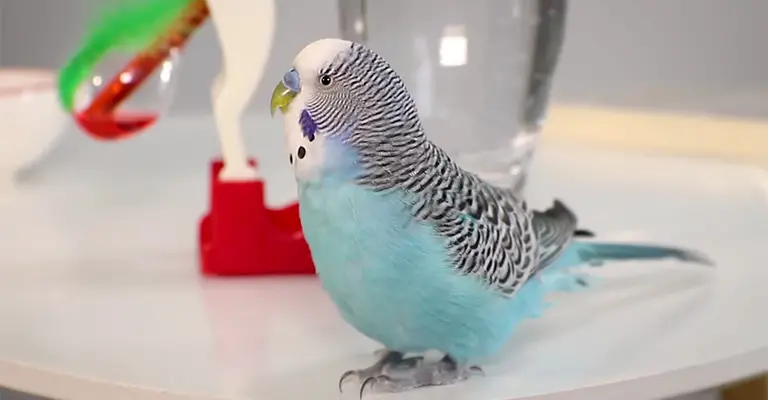Budgies, those colorful and cheerful feathered companions, have an array of fascinating behaviors that often leave their owners intrigued. One such behavior is the mesmerizing act of twirling seed shells in their mouths.
If you’re a budgie owner, you might have observed this curious behavior and wondered why my budgie twirls seed shells in his mouth. Is it just a quirky habit or does it hold a deeper significance?
In this exploration, we delve into the world of budgie behavior to uncover the reasons behind their penchant for twirling seed shells. Join us as we unravel the potential explanations, ranging from instinctual habits to cognitive stimulation.
By understanding this behavior, you can gain insights into your budgie’s world and deepen the bond you share with your feathered friend.
So, let’s embark on a journey to decode the mystery behind why your budgie engages in this captivating behavior.

Why Does My Budgie Twirl Seed Shells in His Mouth?
Budgies twirl seed shells in their mouths for a variety of reasons. One possibility is that it’s an instinctual behavior dating back to their wild ancestors.
Twirling seed shells might help them break down the tough outer layers, making it easier to access the edible part of the seed inside.
This behavior could also serve as a form of mental stimulation, keeping them engaged and preventing boredom. Here are the details:
Instinctual Behavior
One possible reason for budgies twirling seed shells in their mouths is rooted in their natural instincts.
In the wild, budgies need to manipulate objects and interact with their environment to find food and establish nests.
Twirling seed shells might mimic the process of breaking open tough outer layers of seeds they encounter in their natural habitat.
This behavior could be an expression of their inherent curiosity and drive to explore their surroundings.
Seed Shell Preparation
Another hypothesis is that twirling seed shells serves a practical purpose – preparing them for consumption. Budgies are known for their clever approach to accessing the nutrient-rich interior of seeds.
By twirling the shells, they could be loosening or softening them, making it easier to extract the edible parts.
This behavior may demonstrate their ability to adapt to their diet, ensuring they obtain the maximum nutritional value from the seeds they consume.
Cognitive Stimulation
Budgies are intelligent creatures that require mental engagement to thrive. Twirling seed shells might offer cognitive stimulation for these birds. The action involves coordination, focus, and manipulation – all of which challenge their cognitive abilities.
Engaging in such behavior keeps them mentally active and prevents boredom, which is essential for their overall well-being in captivity.
Social and Behavioral Factors

Budgies are social animals that often display behaviors influenced by their interactions with other members of their flock. The twirling of seed shells could have a social component, possibly as a form of communication or mimicry.
Observing this behavior in a captive setting might indicate that the budgie is attempting to engage in a natural behavior, even without the presence of other budgies.
Individual Variation
It’s important to note that individual budgies may exhibit this behavior for unique reasons. Some might twirl seed shells more frequently due to their personal inclinations or past experiences.
This highlights the diversity and complexity of budgie behavior, underscoring the idea that there might not be a single universal explanation for this action.
Sensory Exploration
Budgies, like many animals, explore the world through their senses. Twirling seed shells might be a sensory experience for them, allowing them to feel different textures and tastes.
By manipulating the seed shells in their mouths, they could be gathering sensory information about their environment and the objects they encounter.
Playful Behavior
Budgies are known for their playful nature. Twirling seed shells could simply be a form of entertainment for them.
Similar to how humans fidget or engage in repetitive actions when idle, budgies might find twirling seed shells to be an enjoyable and amusing pastime.
Why Does My Budgie Spit Up Seeds?

One budgie behavior that might leave you puzzled is the act of budgies spitting up seeds. This behavior raises questions about its purpose and significance.
Let’s dive into the possible explanations behind why budgies engage in this curious behavior.
Seed Husk Removal
One common reason budgies spit up seeds is to remove the husks or shells from the edible part.
Budgies are skilled at extracting the nutrient-rich interior of seeds, but they might find the shells less palatable or harder to digest.
By regurgitating the seed shells, they can efficiently separate the indigestible parts, allowing them to focus on consuming the nutritious content.
Digestive Aid
Budgies lack teeth and have a unique digestive system that relies on the gizzard to grind down food.
Spitting up seeds could be a way for budgies to help break down their food further before it enters the gizzard.
By pre-digesting seeds outside the body, budgies might be facilitating the digestive process and making it easier for their bodies to extract nutrients.
Social Interaction
In the wild, budgies are social birds that engage in communal activities, including feeding. Spitting up seeds might serve as a social behavior, especially when observed among a group of budgies.
It could be a form of sharing food or bonding within a flock, even though in captivity, this behavior might be directed towards mirrors, toys, or even their owners.
Mimicking Parental Behavior
Young budgies often observe and mimic their parents’ actions, including feeding behaviors.
Parent budgies regurgitate food for their chicks, and this behavior might carry over into adulthood as a form of instinctual behavior.
Adult budgies might spit up seeds as an expression of this innate behavior, even though they aren’t feeding offspring.
Dietary Discomfort or Regurgitation
In some cases, budgies might spit up seeds due to dietary discomfort or as a regurgitation response. This could be a sign of an underlying health issue, such as crop infections or digestive problems.
If you notice frequent or persistent seed-spitting, it’s advisable to consult a veterinarian to rule out any potential health concerns.
Why Does My Budgie Look Like He’s Choking?

As devoted pet owners, it’s natural to become concerned when our beloved budgies display behaviors that seem unusual or distressing.
If you’ve noticed your budgie appearing as though it’s choking, let’s explore possible reasons behind why your budgie might exhibit choking-like behavior.
Regurgitation and Comfort Behavior
Budgies sometimes display behaviors that resemble choking when they’re actually regurgitating. Regurgitation is a natural behavior in which budgies bring up food from their crop and may present it to a mate, owner, or even a favorite toy.
This can be accompanied by head bobbing and neck stretching, which might look like choking but is a sign of affection and comfort.
Grooming Ritual
Budgies are meticulous groomers, often using their beaks to clean and arrange their feathers. During this process, they might stretch their necks, occasionally causing them to appear as if they’re choking.
This behavior is normal and essential for maintaining their plumage in good condition.
Respiratory Distress
In more concerning situations, budgies might display choking-like behavior due to respiratory distress. Respiratory issues, such as infections, allergies, or foreign object inhalation, can cause labored breathing, wheezing, and choking-like motions.
If you suspect your budgie is struggling to breathe, it’s crucial to seek immediate veterinary attention.
Swallowing Difficulty
Budgies may exhibit choking-like behavior if they have difficulty swallowing. This can be caused by various factors, including an enlarged crop, crop infections, or blockages in the throat.
Swallowing difficulties might result in the bird attempting to clear its throat, leading to behaviors that appear similar to choking.
Foreign Object Ingestion
Sometimes, budgies can accidentally ingest small foreign objects that get stuck in their throats, causing discomfort and choking-like motions.
If you suspect your budgie has ingested a foreign object, it’s vital to consult a veterinarian for appropriate guidance and intervention.
While the sight of your budgie appearing to choke can be distressing, understanding the range of behaviors and potential causes is essential for accurate assessment.
Regurgitation, grooming, and normal behaviors can sometimes resemble choking.
FAQs
Cleaning your budgie’s cage is crucial for maintaining their health. Aim to clean the cage at least once a week.
This involves removing droppings, and uneaten food, and replacing soiled bedding. Additionally, provide fresh water daily and sanitize food and water dishes during each cleaning.
Yes, budgies are known for their ability to mimic human speech. Teaching a budgie to talk requires patience and consistent repetition.
Start with simple words or phrases and repeat them clearly and frequently. Your budgie might not achieve perfect pronunciation, but they can certainly learn to mimic sounds.
A well-rounded budgie diet includes a mix of high-quality budgie seed mix, fresh vegetables, and occasional fruit treats.
Pelleted budgie food can also provide balanced nutrition. Make sure to avoid giving them avocados, chocolate, caffeine, and high-sugar or high-salt foods.
Signs of illness in budgies include changes in behavior, fluffed feathers, labored breathing, discharge from the eyes or nostrils, loss of appetite, and reduced activity.
If you notice any of these signs, it’s crucial to consult an avian veterinarian for a proper diagnosis and treatment.
Budgies are social birds and often enjoy the company of their own kind. It’s generally recommended to keep budgies in pairs or small groups, as they can interact, groom each other, and vocalize together.
Conclusion
The twirling of seed shells by budgies is a fascinating behavior that offers us a glimpse into their complex world. While there may not be a definitive answer, several plausible explanations shed light on this quirky habit.
It could be rooted in their natural instinct to manipulate objects or a way to break down the tough seed shells for easier consumption. The behavior might also serve as a form of cognitive stimulation, providing mental engagement and preventing boredom.
Whatever the exact reason, observing your budgie twirl seed shells offers a chance to appreciate their unique traits. As responsible pet owners, understanding such behaviors not only enriches our companions’ lives but also deepens the bond we share with them.
By providing a stimulating environment, a balanced diet, and opportunities for interaction, we can ensure our budgies lead happy and fulfilling lives.